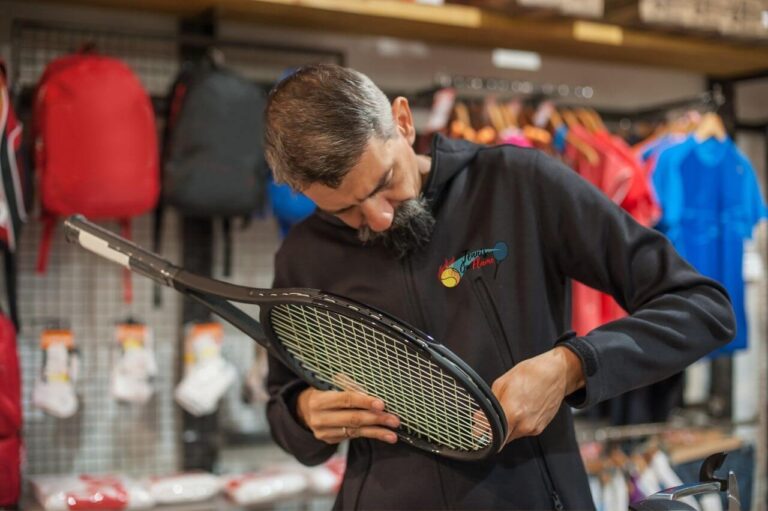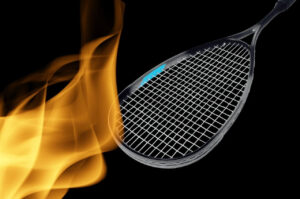When you’re shopping for a new tennis racket, one of the most important decisions you’ll make is what kind of strings to put on it.
There are many different types of tennis strings available, made from a variety of materials. So, which ones should you choose? And do they make a difference?
In this guide, we will explore the different types of tennis strings available and discuss the pros and cons of each type.
We will also help you figure out which strings are right for your game.
Join me!
So… do tennis racket strings make a difference?
Yes, the string on your racket can have as much of an impact as the racket itself.
If you find a string that fits together with your racket, you will feel more confident and perform better when playing.
In general, thinner strings are easier to play, with more power and comfort while thicker strings last longer, and with more control.

What is the thickness of tennis strings?
The thickness of tennis strings is typically classified by numbers, with 15 being the thickest and 19 being the thinnest.
There is also something called “half-gauges”, which are denoted by an L (ex. 15L, 16L) and stand for light.
What are the main types of tennis racket strings?
The main types of tennis racket strings are natural gut, nylon (multifilament), and polyester (monofilament).
Different types of tennis strings offer unique benefits to players.
Natural gut and nylon strings are more comfortable and powerful, making them ideal for beginner to intermediate players.
Polyester is stiffer and offers more control, making it better suited for the advanced player.
As you can see, there are different types of string available, so it is important to find something that suits your needs.
Experiment with a few different types to find what works best for you.
What should I consider when choosing tennis racket strings?
When choosing tennis racket strings, you should consider a few things:
First, you need to find out what is the best tennis racket string that fits your playing style.
-Are you a beginner or a junior player?
Power string made of natural gut or nylon might be the right choice for you.
-Are you an experienced power player, and want more control over the ball?
Polyester string or even nylon will give you the control that you need.
-Are you suffering from tennis elbow or arm injuries? Do you want more comfort and less feel of shock vibration?
Natural gut or nylon strings, which are considered flexible materials, offer you the comfort you need.
-Are you a competitive player that participates in tournaments, uses spin for attacks and is spin a big issue in the way you play?
Polyester strings will do the work!
Secondly, you need to determine the thicknesses (gauge) of your stings.
The 16 gauge is one of the most popular string gauges used today.
that string size falls between 1.25mm and 1.34mm. 16 gauge is thicker than 17 gauge, resulting in more durability and easier control for the player.
A medium thin gauge at 17/1.25mm. It is best suited for beginner to intermediate players who value comfort and power.
The 17L/1.20mm string is thin, which makes it ideal for players who prioritize touch and feel.
18/1.15mm: The thinnest gauge string- set; recommended for players wanting the utmost touch and feel.
Finally, you need to consider Your budget: String can vary in price, so it is important to find something that fits your budget.
What string do most pros use?
Most pros use polyester strings to achieve better control, spin, and power.
Polyester strings can give you a more aggressive feel and are good for hard-hitting players who require lots of spin on their shots.
However, After 10 to 20 hours of playing, tension loss occurs more quickly with polyester string than with other strings because it is not as elastic, so be prepared to replace them often.
How often should you replace your tennis racket strings?
There is no definitive answer as to how often you should replace your tennis racket strings.
However, you should replace your racket strings per year as frequently as you play tennis per week, unless they break before then.
For example, if you play three times a week, you need to replace your racket strings three times a year.
It is important to monitor the condition of your strings and look out for signs of wear such as fraying or breakage.
If you notice any issues with your strings, they should be replaced immediately.
How can I make my tennis racket strings last longer?
To make your tennis racket strings last as long as possible, it is important to take care of them.
You should avoid leaving your racket on the floor or a damp surface, and store it in its case when you are not using it.
You should also wipe down both sides of the strings after each use and keep them away from heat and sunlight.
If you’re looking for more durability, try a thicker gauge size or 2. You might also want to switch to an alternative string material.
Finally, besides the string thicknesses, you can change the material of the string.
The multifilament string can be changed to a synthetic gut or polyester string for more durability.
What is the best string tension for tennis rackets?
The string tension of a tennis racket is determined by the individual player’s style and preference.
Generally, recreational players should select a lower tension (48 to 54 lbs.), while more advanced players may opt for a higher tension (54 kg and above).
How does the string tension affect the player’s performance?
The string tension of a racket can affect the player’s performance.
For example, More power is given with low-tension, and high-tension strings making it easier for you to hit consistent, topspin shots with more control.
What does the term “gut” mean about tennis racket strings?
The gut is a type of string made from the intestines of sheep or cows. It is more expensive than synthetic strings and has a natural feel.
What does the term “synthetic” mean about tennis racket strings?
The term synthetic refers to any type of string that is made from materials other than gut (such as nylon). These types of string are more affordable than gut, but they do not have the same natural feel.
What is a hybrid string?
A hybrid string is made out of two or more different types of string. For example, natural gut might be used in the mains and synthetic in the crosses.
Where can you purchase tennis racket strings?
Strings can be purchased at a local sporting goods store, online retailers such as Tennis Warehouse or Amazon, or directly from the string manufacturer.
It is important to shop around and compare prices to get the best deal possible.
You can also purchase tennis racket strings by clicking here!
In conclusion:
Choosing the right string for your tennis racket is an important decision that will affect your game.
It is important to consider the feel, power, control, and durability of each type of string as well as your budget when selecting a string.
The main types of tennis racket strings are natural gut, nylon (multifilament), and polyester (monofilament).
Each type has its advantages and disadvantages, so it is best to experiment with different strings to find the one that works best for you.
The 16 gauge is one of the most popular string gauges used today.
Remember that the tension of the strings will also impact your performance and choosing the right tension is essential.
Finally, you should replace your racket strings per year as frequently as you play tennis per week, unless they break before then, and don’t forget to take care of your strings by storing them in a safe place, wiping them down after each use.
I hope you enjoyed this comprehensive guide.
Stay tuned for more posts about interesting topics in the world of tennis!
If you have any further questions, please feel free to leave a comment below, and I will be happy to answer you! 🙂
Please check out my other blog posts for more informative guides that can help your game.
Thanks for reading, and have a nice day! 🙂








